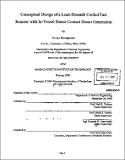| dc.contributor.advisor | Neil E. Todreas, Mujid S. Kazimi, and Kenneth R. Czerwinski. | en_US |
| dc.contributor.author | Buongiorno, Jacopo | en_US |
| dc.contributor.other | Massachusetts Institute of Technology. Dept. of Nuclear Engineering. | en_US |
| dc.date.accessioned | 2006-03-29T18:24:00Z | |
| dc.date.available | 2006-03-29T18:24:00Z | |
| dc.date.copyright | 2001 | en_US |
| dc.date.issued | 2001 | en_US |
| dc.identifier.uri | http://hdl.handle.net/1721.1/32205 | |
| dc.description | Thesis (Ph.D.)--Massachusetts Institute of Technology, Dept. of Nuclear Engineering, 2001. | en_US |
| dc.description | Includes bibliographical references (p. 357-366). | en_US |
| dc.description.abstract | The feasibility of a lead-bismuth (Pb-Bi) cooled fast reactor that eliminates the need for steam generators and coolant pumps was explored. The working steam is generated by direct contact vaporization of water and liquid metal in the chimney above the core and then is sent to the turbine. The presence of a lighter fluid in the chimney drives the natural circulation of the Pb- Bi within the reactor pool. Three key technical issues were addressed: 1) the maximum thermal power removable by direct contact heat transfer without violating the fuel, clad and vessel temperature limits, 2) the consequences of Pb-Bi aerosol transport on the design and operation of the turbine and 3) the release of radioactive polonium (a product of coolant activation) to the steam. Modeling of the multi-phase phenomena occurring in the chimney confirmed the effectiveness of the direct contact heat transfer mode within a well-defined design envelope for the reactor power, chimney height and steam superheat. A 1260MWth power is found possible for 10m chimney height and 25°C superheat. The temperature of the low-nickel steel clad is maintained below 600°C, which results in limited corrosion if tight control of the coolant oxygen concentration is adopted. | en_US |
| dc.description.abstract | Generation, transport and deposition of Pb-Bi aerosols were also modeled. It was found that the design of a chevron steam separator reduces the heavy liquid metal in the steam lines by about three orders of magnitude. Nevertheless, the residual Pb-Bi is predicted to cause embrittlement of the turbine blades. Four solutions to this problem were assessed: blade coating, employment of alternative materials, electrostatic precipitation and oxidation of the Pb-Bi droplets. An experimental campaign was conducted to investigate the polonium release from a hot Pb- Bi bath to a gas-streamn. Th thermodynamics of the polonium hydride formation reaction (free- energy vs. temperature). as welQ as the vapor pressure of the lead-polonide were measured and then utilized to model the polonium transport in the reactor. It was found that the polonium concentration in the steam and on the surface of the power cycle components is significantly above the acceptable limits, which makes the very concept of a direct contact reactor open to question. | en_US |
| dc.description.statementofresponsibility | by Jacopo Buongiorno. | en_US |
| dc.format.extent | 366 p. | en_US |
| dc.format.extent | 22578044 bytes | |
| dc.format.extent | 22641214 bytes | |
| dc.format.mimetype | application/pdf | |
| dc.format.mimetype | application/pdf | |
| dc.language.iso | eng | en_US |
| dc.publisher | Massachusetts Institute of Technology | en_US |
| dc.rights | M.I.T. theses are protected by copyright. They may be viewed from this source for any purpose, but reproduction or distribution in any format is prohibited without written permission. See provided URL for inquiries about permission. | en_US |
| dc.rights.uri | http://dspace.mit.edu/handle/1721.1/7582 | |
| dc.subject | Nuclear Engineering. | en_US |
| dc.title | Conceptual design of a lead-bismuth cooled fast reactor with in-vessel direct-contact steam generation | en_US |
| dc.type | Thesis | en_US |
| dc.description.degree | Ph.D. | en_US |
| dc.contributor.department | Massachusetts Institute of Technology. Department of Nuclear Engineering | en_US |
| dc.contributor.department | Massachusetts Institute of Technology. Department of Nuclear Science and Engineering | |
| dc.identifier.oclc | 48757533 | en_US |
